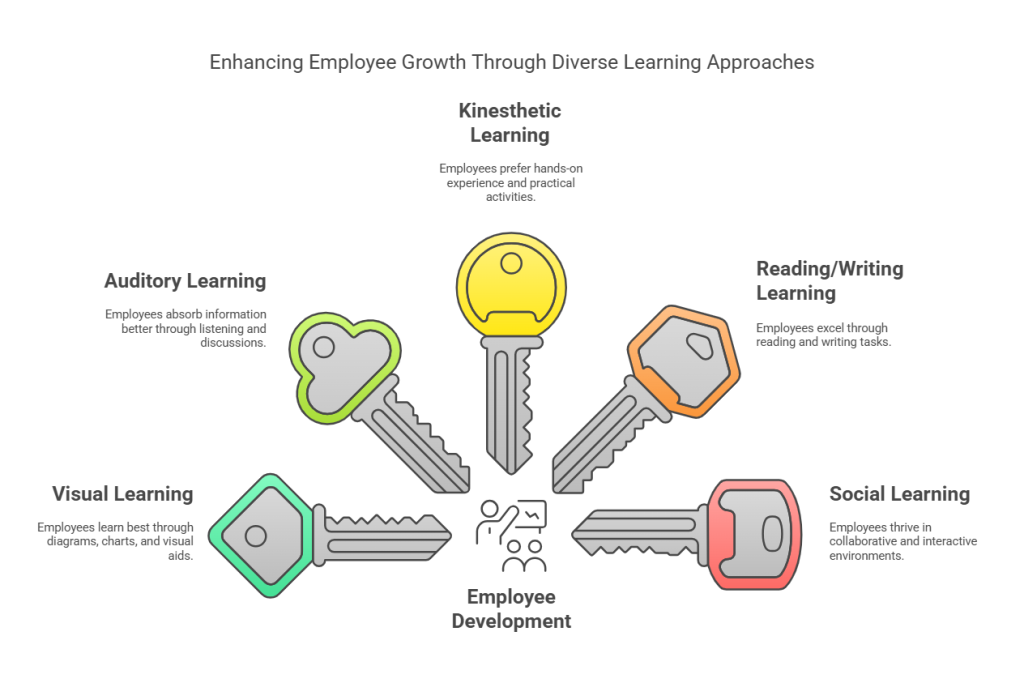Understanding the diverse learning styles within your workforce is crucial for effective employee development. By catering to these different styles, organizations can enhance engagement, improve retention, and ultimately drive better performance.
This blog will discuss five key learning styles and provide actionable strategies to accommodate them in your training programs.
The Importance of Recognizing Learning Styles
In today’s workplace, employees come from various backgrounds and possess unique ways of absorbing information. Ignoring these differences can lead to disengagement and ineffective training. By recognizing and adapting to individual learning preferences, organizations can create a more inclusive environment that promotes continuous growth and development.
Pain Points in Employee Development
Many companies still rely on a one-size-fits-all approach when it comes to training. This often results in:
Disengaged Employees: When training does not resonate with their preferred learning style, employees may lose interest.
Poor Knowledge Retention: Information presented in an unsuitable format can be difficult for employees to remember.
Wasted Resources: Ineffective training methods can lead to wasted time and money, as employees struggle to apply what they have learned.
By addressing these pain points through tailored training programs, organizations can significantly improve employee satisfaction and productivity.
1. Visual Learning
Characteristics: Visual learners grasp information best through images, diagrams, charts, and videos. They often benefit from seeing concepts represented visually rather than through text alone.
Strategies to Cater to Visual Learners:
- Incorporate infographics and visual aids in presentations.
- Use video tutorials or webinars to explain complex topics.
- Create mind maps or flowcharts to illustrate processes.
2. Auditory Learning
Characteristics: Auditory learners excel when they hear information. They prefer discussions, lectures, and audio materials over visual content.
Strategies to Cater to Auditory Learners:
Implement group discussions or brainstorming sessions.
Provide audio recordings of training materials for review.
Encourage participation in seminars or workshops where listening is key.
3. Kinesthetic Learning
Characteristics: Kinesthetic learners thrive on hands-on experiences. They learn best by doing and often prefer physical activities over traditional classroom settings.
Strategies to Cater to Kinesthetic Learners:
a. Design interactive workshops that involve role-playing or simulations.
b. Incorporate real-life scenarios into training sessions for practical application.
c. Use tools like games or challenges that require physical involvement.
Also Read
How to Effectively Onboard Employees with a Development Focus
How to Build an Employee Development Calendar for 2025
4. Reading/Writing Learning
Characteristics: These learners prefer written words and often excel at reading texts and writing notes. They benefit from traditional educational methods that emphasize reading and writing assignments.
Strategies to Cater to Reading/Writing Learners:
- Provide comprehensive manuals or articles for self-study.
- Encourage written assignments such as reports or essays related to the training material.
- Use message boards or online forums for discussions that require written contributions.
5. Social Learning
Characteristics: Social learners are energized by interaction with others. They thrive in collaborative environments where they can share ideas and learn from peers.
Strategies to Cater to Social Learners:
– Foster team-building activities that promote collaboration.
– Create peer mentoring programs where experienced employees guide newcomers.
– Organize group projects that encourage teamwork and collective problem-solving.
Implementing a Tailored Training Approach
To effectively implement these strategies, consider the following steps:

Assess Learning Styles
Conduct assessments or surveys to identify the predominant learning styles within your team. Understanding your employees’ preferences will help you tailor your training programs accordingly.
Offer Flexible Learning Opportunities
Provide various options for learning formats—such as online courses, workshops, and self-paced tutorials—to accommodate different styles. Giving employees the choice allows them to engage with the material in a way that suits them best.
Customize Training Sessions
Design training modules that can be adjusted based on the identified learning preferences. For instance, include a mix of visual aids, hands-on activities, and written materials in each session.
Encourage Continuous Feedback
Regularly solicit feedback from employees regarding the effectiveness of training methods. This will help you refine your approach over time and ensure it meets their evolving needs.
Conclusion: Learning Styles
Catering to different learning styles is not just about improving employee development; it’s about creating a culture of inclusivity that values individual differences. By recognizing how people learn best and adapting your training programs accordingly, you can enhance engagement, boost retention rates, and foster a more productive workplace.
Investing time in understanding your workforce’s learning preferences will pay off in the long run leading not only to improved performance but also greater job satisfaction among employees. Embrace these strategies today, and watch as your team’s potential unfolds.
